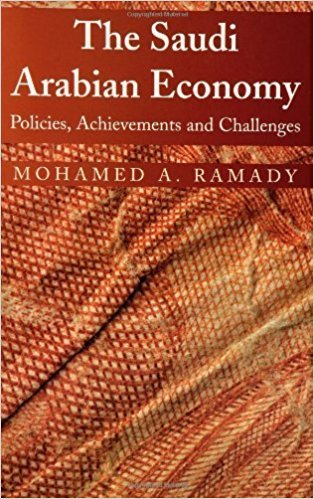Description
This post is also available in:
![]() العربية (Arabic)
العربية (Arabic)
The Saudi Arabian Economy: Policies, Achievements and Challenges
The Saudi Arabian Economy: In this unique text, Mohamed Ramady develops a framework for studying fundamental challenges to the modern Saudi Arabian economy. Public and private sector topics include:
– The hydrocarbon and minerals sector, including a new model of mining privatization and cooperation – The impact of small and medium sized businesses – The evolving role of ‘family’ businesses – The growing role of women in the Saudi economy – Shifting trade patterns – The Saudi ‘offset’ technology transfer program The author offers an analysis of key challenges facing the Saudi economy, including the potential costs and benefits of privatization, globalization, and eventual membership in the WTO.
Employment, education, economic and social stability, and Saudi Arabia’s place in the Gulf Cooperation Council are offered as keys to the consensus building needed to ensure the Kingdom’s healthy economic future. Mohamed Ramady
With the current price of oil steadily increasing past 60 dollars a barrel over the past few months and the recent succession of Crown Prince Abdallah to the throne, Saudi Arabia has been once again been propelled into the lime-light. What transpires in the Kingdom, and the policies it takes concerning internal economic and social reforms, as well as its energy policies have a bearing far beyond its shores. As such , any serious effort at understanding the country’s internal economic structure and the direction of change should be welcomed, especially when there is a paucity of first class research emanating from those who have first hand experience on the Kingdom.
Many books have been written on Saudi Arabia in recent times, ranging from personal anecdotes about life in the desert Kingdom, to more serious scholarly work, mostly by researchers outside Saudi Arabia. The latter are often hampered by their inability to obtain first hand data and carry out field research, and more often than not, tend to dwell on issues of internal stability and political dissent.
The Saudi Arabian Economy by Dr Mohamed Ramady provides a clear exposition of the recent economic history of the Kingdom and is a welcome addition to those with a serious interest in the workings of the Saudi Arabian economy, bringing a fresh perspective in some key areas such as the workings of the Saudi Arabian Monetary Agency, the Saudi capital markets, the problem of a growing unemployment and the globalization challenges facing the Kingdom.
The author combines an academic as well as a professional 20 year banking career with international financial institutions, spanning Europe and the Middle East, particularly Saudi Arabia. He brings this experience to bear in the chapters of most interest to this magazine’s readers .
While the book is intended as a reference source for senior level university students, it is also aimed at the general reader and practitioners interested in Saudi Arabia. Several inter-related themes are explored, with each theme grouping particular chapters that can be read in isolation depending on the readers’ interest.
The author analyzes the inherent weakness of the Saudi budgetary framework, with recurrent deficits and a ballooning of internal debt- around 90% of Gross Domestic Product (GDP). The centrality of oil income in economic growth and the urgent need to diversify Saudi Arabia’s sources of revenues, including taxation, are explored in depth.
If the introductory pages suggest a softer Saudi “go-it-alone” approach, the analysis does not shy away from difficult subjects. Issues such as treatment of foreign labor and their eventual replacement by qualified Saudis are treated with a degree of urgency, if the policy of Saudization is to succeed.
This could become one of the most contentious issues in the years ahead. Most books on the Saudi economy have tended to discuss the matter in purely statistical terms.
They have neglected to delve more deeply, beyond the numbers, to assess the potential economic implications should the policy of Saudization be mishandled.
The warning signs are already there, if one examines the number of Saudi companies that have moved their operations to more labor policy friendly Gulf countries.
The Saudi capital markets are extensively discussed, including the operating regulatory framework and various obstacles to an economically efficient market. The issue of ownership concentration and lack of depth of the largest Arab stock market is analyzed and recommendations are made to widen the market base.
Throughout, the book emphasizes the growing importance of the Saudi private sector as being at the heart of the Kingdom’s revenue generation, economic diversification and value added job generation if future challenges are to be met.
The role of the family businesses is explored, as well as the growing and effective contribution of the Saudi women in economic development, despite continuing obstacles to their effective participation.
Throughout the book, the author argues for more effective women role in the national economy and allowing them wider participation.
The book also explores Saudi Arabia’s multi-faceted relationship with the other five members of the Gulf Cooperation Council (GCC), as developments within the GCC could have far reaching economic and social consequences for the member states.
The author examines how far similarities and differences between the GCC states could accelerate or impede their planned full monetary and customs union by 2010, with special attention paid to capital market reforms and economic liberalization as means for further GCC integration. Reform, although implemented gradually, can be cumulative in effect.
Gradual change may seem slow or less impressive to those outside the Kingdom, and compared to fast paced developments of other Gulf countries, but the author argues that in the case of Saudi Arabia if reforms are to succeed and be effective they have to respond to the needs, customs and mores of all society. Consensual change will be the means of change for Saudi Arabia.
If the first action of the newly appointed King Abdallah is anything to go by, the author has truly put his finger on the pulse of how Saudi Arabia is evolving and facing its future challenges.
The writing is fluid, easy to understand and uses a great deal of illustrations and personal examples, as well as end of chapter summaries and one of the most comprehensive and up to date reference bibliographies on Saudi Arabia.
teaches in the Department of Finance and Economics, King Fahd University of Petroleum and Minerals.
The Saudi Arabian Economy: Policies, Achievements and Challenges
For more books
This post is also available in:
![]() العربية (Arabic)
العربية (Arabic)

 العربية
العربية  English
English 



